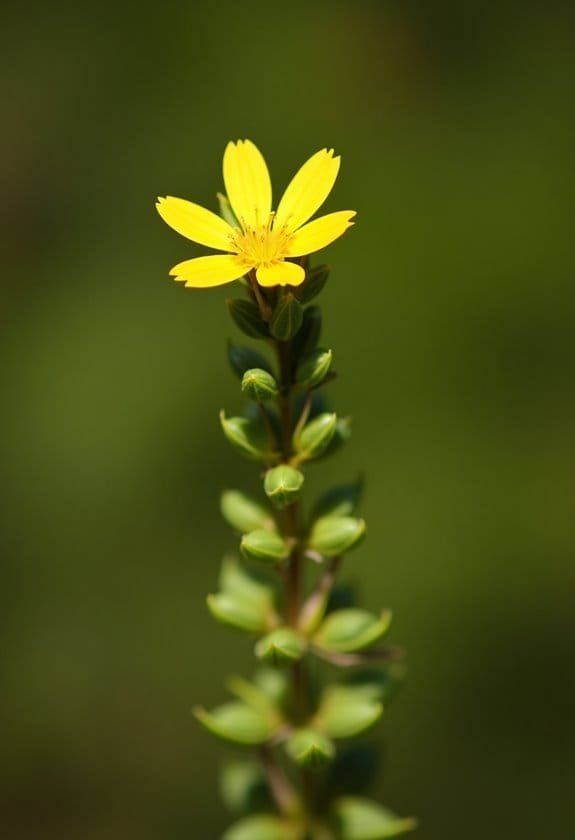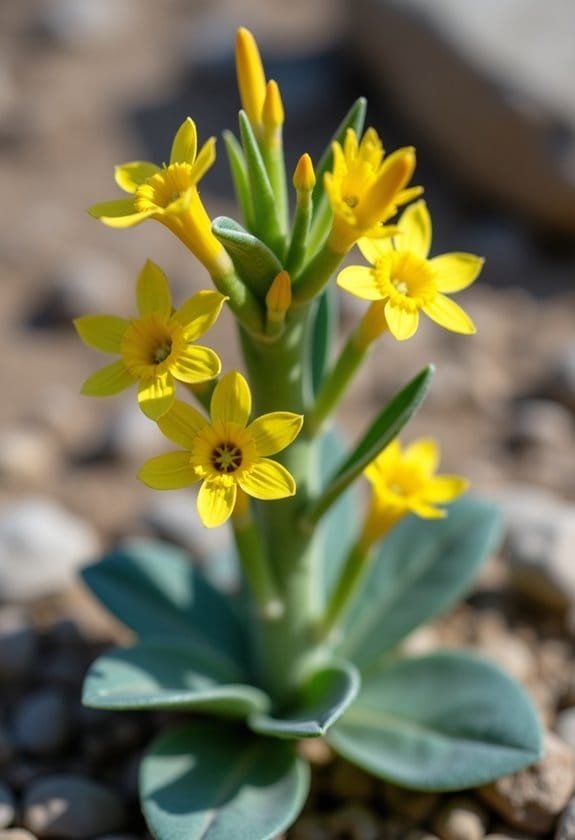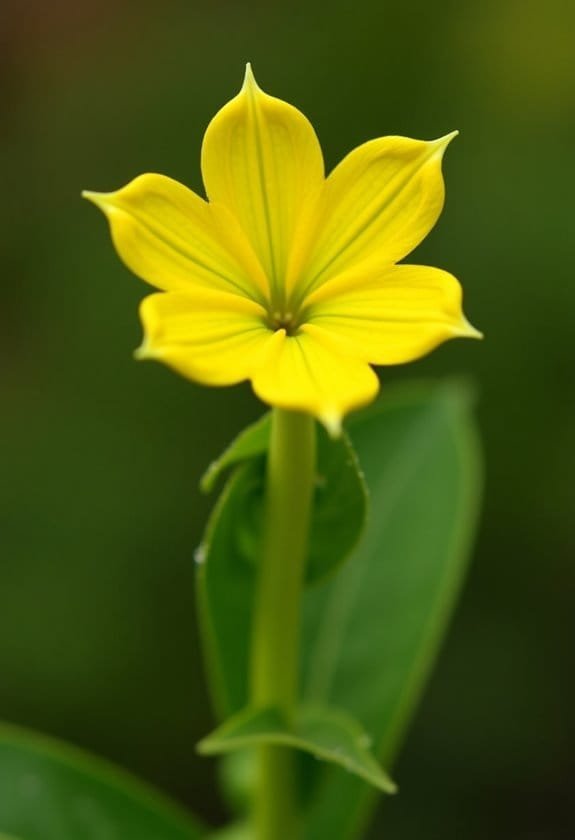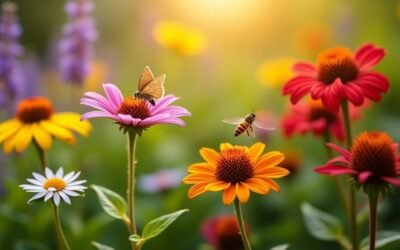Yellowwort (Blackstonia perfoliata) is a distinctive Mediterranean annual herb that showcases bright yellow cup-shaped flowers measuring 1-1.5 centimeters across. It's characterized by unique bluish-green perfoliate leaves that completely encircle the stem, growing to heights between 10-50 centimeters. The plant thrives in alkaline conditions, particularly in chalk grasslands and coastal regions, where it flowers from June to October. This resilient species plays a significant role in supporting pollinator populations, especially bees and butterflies, through its extended blooming period. Its specific growing requirements and ecological significance make it an intriguing subject for both botanists and gardening enthusiasts who appreciate its unique characteristics.
Main Points
- Yellowwort is a wildflower with bright yellow cup-shaped flowers and bluish-green leaves that wrap around its stems.
- The plant grows 10-50cm tall and features 6-10 petaled flowers that bloom from June to October.
- It thrives in alkaline soils, particularly in chalk grasslands, limestone areas, and coastal regions with well-drained conditions.
- The species acts as an important nectar source for pollinators, especially bees and butterflies, throughout its extended blooming period.
- Conservation efforts focus on habitat maintenance through grazing and hay-cutting, protecting against threats from urbanization and competing vegetation.
Introduction

Yellowwort (Blackstonia perfoliata) stands out among chalk grassland flora with its striking bright yellow flowers and distinctive glaucous leaves.
The plant's remarkable adaptation to alkaline soils has made it a characteristic species of limestone regions and coastal dunes, where it grows to heights between 10 and 50 centimeters.
Its scientific classification places it within a group of plants known for their symmetrical flowers, featuring 6 to 10 petals that form a tubular structure and attract various pollinators during its blooming period from June to October.
Common Name
The bright yellow flowers found in the grasslands of Britain belong to Blackstonia perfoliata, commonly known as Yellowwort. This distinctive member of the family Gentianaceae earned its common name from the vibrant, cup-shaped blooms that grace its stems from early summer through autumn.
The name "Yellowwort" perfectly captures the plant's most striking feature: its intensely yellow flowers that illuminate chalk grasslands and limestone areas across England and Wales. These blossoms, which appear between June and October, have become a defining characteristic that helps botanists and nature enthusiasts easily identify the species in its natural habitat.
The "wort" suffix, derived from Old English, historically indicated a plant with medicinal or useful properties, though today it serves primarily as a traditional naming convention. The plant's scientific name, Blackstonia perfoliata, references another distinctive feature – its perfoliate leaves that appear to be pierced by the stem, creating a unique visual effect that complements its memorable common name.
This characteristic, combined with its glaucous foliage, makes Yellowwort instantly recognizable in its preferred alkaline environments.
Scientific Name
Each botanical species requires a precise scientific name, and Blackstonia perfoliata (L.) Huds. serves as the taxonomic designation for Yellowwort. This scientific classification, firmly established within the Gentianaceae family, honors the notable English botanist John Blackstone through its genus name.
The species name "perfoliata" draws attention to one of the plant's most distinctive features: its leaves appear to be fused together around the stem, creating a perfoliate arrangement that distinguishes it from related species. The notation "(L.)" in the scientific name acknowledges Carl Linnaeus, the renowned Swedish botanist who first described this species in his groundbreaking taxonomic work. The "Huds." designation refers to William Hudson, who later refined the classification.
This meticulous naming system provides valuable insights into the plant's characteristics and habitat preferences, as Blackstonia perfoliata typically thrives in chalk and limestone environments throughout Europe.
The scientific name serves as a permanent reference point for researchers and botanists studying this striking yellow-flowered species, ensuring consistent identification across different languages and regions.
Overview
Standing gracefully in chalk grasslands and limestone areas, Blackstonia perfoliata captures attention with its brilliant yellow, cup-shaped flowers and distinctive perfoliate leaves. This remarkable wildflower, reaching heights between 10 and 50 centimeters, displays a unique adaptation where its leaves completely encircle the stem, helping the plant retain water in its often-dry habitats.
A member of the Gentianaceae family, Blackstonia flourishes in specific ecological niches, establishing itself primarily across Central and Southern England, Wales, and selected coastal regions. The plant's preference for chalk, limestone, and sand dunes demonstrates its specialized nature, making it an important indicator species for these habitats.
Its flowering period spans from June to October, during which the plant produces striking blooms featuring six to ten petals arranged in a tubular formation. These flowers serve as essential resources for various pollinators, contributing greatly to local ecosystem diversity.
Conservation efforts focus on maintaining appropriate habitat conditions through carefully timed grazing and hay-cutting practices, ensuring the survival of this distinctive yet vulnerable species.
Key Features
Yellowwort stands as a distinct wildflower, reaching heights between 10 and 50 centimeters with its stiff, branching stems and unique perfoliate leaves that appear to encircle the stem.
The plant's most striking feature is its bright yellow flowers, measuring 1 to 1.5 centimeters across, which consist of 6 to 10 petals arranged in terminal cymes.
These eye-catching blooms emerge from June through October, with the plant reaching peak flowering during the height of summer in July and August.
Growth Size
The striking wildflower typically reaches heights between 10 and 50 centimeters (3.9-19.7 inches), with some specimens growing up to half a meter tall. Known scientifically by the name Blackstonia perfoliata, this plant exhibits a remarkable growth pattern characterized by its rigid, branching stem structure that supports its distinctive foliage arrangement.
The plant's height complements its unique architectural features, particularly in how the leaves are positioned around the stem. The upper ones demonstrate an interesting fusion, creating the illusion of a single leaf completely encircling the stem's circumference. This characteristic growth pattern allows the plant to maximize its exposure to sunlight while maintaining its relatively modest stature among neighboring vegetation.
During its peak growing season, which coincides with its flowering period from June to October, the plant displays its full vertical development. The terminal cymes of bright yellow flowers, measuring 1-1.5 centimeters across, crown the plant's upright form, creating an eye-catching display that stands out despite its moderate height range.
Appearance
Among its most striking visual characteristics, Blackstonia perfoliata showcases a distinctive set of features that make it easily identifiable in its natural habitat. The plant's stiff, branching stems support a remarkable arrangement of glaucous leaves that exhibit a unique perfoliate structure, where upper leaves appear to completely encircle the stem.
The plant's most enchanting feature is its vibrant yellow flowers, which measure between 1-1.5 centimeters across and create stunning color variations against their green backdrop. These blossoms, appearing from June through October, display six to ten petals that unite to form a short tube, creating an elegant star-like pattern.
The flowers' architectural complexity is enhanced by their deeply divided calyx, featuring linear lobes that complement the corolla while remaining shorter in length. The leaf arrangement demonstrates perfect symmetry, with opposite pairs positioned along the stem, reflecting the plant's adaptation to its habitat preferences.
During peak flowering months of July and August, the plant transforms its surroundings into a brilliant display of golden blooms, making it a notable presence in its ecosystem.
Flowering Season
During Britain's warmer months, Blackstonia perfoliata bursts into bloom, displaying its vibrant yellow flowers from June through October. The flowering duration reaches its pinnacle during July and August, when the plant produces its most abundant blossoms, each measuring between 8 to 15 millimeters in diameter.
These distinctive flowers, arranged in lax, branched clusters, showcase 6 to 8 pointed petals that overlap to create an eye-catching cup-shaped formation. The plant's pollinator attraction strategy includes not only its bright coloration but also an intriguing daily ritual: the flowers close their petals in the afternoon, a characteristic that sets them apart from many other wildflowers.
The ecological importance of Yellowwort's flowering season extends beyond its aesthetic appeal. During these essential months, the plant serves as a critical resource for various pollinators, contributing considerably to local biodiversity.
The extended blooming period guarantees a consistent food source for insects throughout the summer and early autumn, making it an integral component of Britain's complex ecological web.
Growing Requirements

Yellowwort's success hinges on its specific environmental requirements, particularly its need for well-drained, calcareous soils in full sunlight.
The plant flourishes in alkaline conditions typically found on chalk downland slopes and limestone meadows, where it can establish itself without intense competition from other species.
Its peak growing season corresponds with warmer summer temperatures from June through October, making it well-suited to Mediterranean-style growing conditions where it receives minimal water and thrives in nutrient-poor soil.
Light
One of the most critical requirements for growing yellowwort is abundant sunlight. This Mediterranean-adapted plant demonstrates a strong preference for full sunlight exposure, making it particularly well-suited to open, exposed locations where light intensity remains consistently high throughout the day.
Yellowwort's relationship with sunlight extends beyond mere survival, as its flowering cycle from June through October coincides with periods of maximum daylight hours. The plant shows minimal shade tolerance, which explains its natural distribution across chalk downlands and coastal dunes where tall vegetation rarely blocks incoming light.
In environments where light is filtered or partially obscured, yellowwort typically struggles to establish itself and may fail to produce its characteristic yellow blooms.
The plant's adaptation to high-light environments complements its preference for well-drained, calcareous soils, creating a specialized ecological niche. This combination of specific light requirements and substrate preferences explains why yellowwort thrives in limestone pavements and chalk slopes, where competing vegetation remains sparse and sunlight reaches the ground unimpeded.
Soil
In relation to soil requirements, yellowwort demonstrates a strong preference for calcareous environments, particularly those rich in chalk and limestone. The plant's affinity for well-drained, alkaline soil types has shaped its distribution patterns, making it a reliable indicator species for calcium-rich substrates.
This specialized adaptation to specific nutrient conditions guarantees yellowwort thrives alongside other calcicoles, or lime-loving plants, in its preferred habitats. The species' root system has evolved to extract essential minerals from these distinctive soils, while its overall health depends on the careful balance of drainage and mineral composition that chalk and limestone naturally provide.
Effective habitat management plays a significant role in maintaining ideal soil conditions for yellowwort populations. Regular grazing regimes and strategic hay-cutting help prevent the accumulation of organic matter that might alter the soil's chemical composition.
These management practices preserve the open, well-drained character of the substrate, guaranteeing the continuation of the precise growing conditions that support yellowwort's lifecycle and reproduction in its characteristic chalk grassland environments.
Water
In harmony with its limestone habitat preferences, yellowwort requires carefully balanced water conditions that emphasize proper drainage over excessive moisture. This Mediterranean-adapted plant employs natural water conservation strategies, making it an excellent choice for gardens focused on sustainable irrigation methods.
During the vital establishment phase, yellowwort benefits from strategic supplemental watering to develop a robust root system that enhances its drought resilience techniques. Once established, the plant demonstrates remarkable adaptability to water-scarce conditions, though it maintains ideal growth with moderate moisture levels during its active growing season from June through October.
Like many chalk-loving species, yellowwort's relationship with water mirrors its natural habitat, where brief periods of moisture alternate with extended dry spells.
Implementing efficient irrigation methods becomes essential when cultivating yellowwort, as waterlogged conditions can compromise its health and survival. Gardeners should focus on providing consistent but measured hydration that mimics the plant's native environment, where well-drained soils prevent water accumulation while retaining sufficient moisture for sustained growth.
Temperature
Depending on environmental conditions, yellowwort exhibits excellent growth when temperatures range from 15°C to 25°C (59°F to 77°F) during its active growing season. This remarkable climate adaptability stems from the plant's evolutionary development in temperate regions, where it has developed mechanisms to thrive in warm, dry conditions.
The plant's temperature requirements align perfectly with its flowering period, which occurs from June through October when seasonal growth is at its peak. During these months, the warmth not only supports robust development but also attracts essential pollinators to the bright yellow blooms.
The plant's bluish-green waxy leaves play a significant role in managing temperature fluctuations, acting as natural insulators that help maintain ideal internal temperatures while conserving moisture. This adaptation is particularly valuable during brief heat waves or unexpected temperature changes.
The plant's preference for alkaline soils, typically found in chalk or limestone environments, further supports its temperature regulation. These mineral-rich substrates help buffer against extreme temperature variations, while full sun exposure enables the plant to maintain its excellent temperature range throughout the growing season.
Pollinator Criteria
Yellowwort's vibrant yellow flowers serve as beacons for a diverse array of pollinators, particularly bees and butterflies seeking nectar during the summer months.
The plant's distinctive flower structure, featuring six to ten petals arranged in a tubular formation, provides an ideal landing platform and guarantees efficient pollen transfer between plants.
The species' strategic afternoon flower closure pattern aligns with the activity periods of its primary pollinators, who visit during cooler morning hours when the blooms are fully open and nectar production peaks.
Attracted Pollinators
Bright yellow blossoms make Yellowwort a significant attraction for various pollinating insects during its flowering period from June to October. The plant's distinctive cup-shaped flowers, featuring six to ten petals arranged in a tubular formation, have evolved to accommodate specific pollinator preferences, particularly those of bees and other nectar-seeking insects.
The species' natural habitat in chalk and limestone grasslands provides substantial habitat benefits for diverse butterfly and moth populations, which play a vital role in the plant's reproductive success.
These pollinators are drawn to the abundant nectar sources during the warmer months, establishing a mutually beneficial relationship that supports both the plant's survival and the insects' nutritional needs.
Conservation strategies often focus on maintaining these chalk grassland ecosystems, as they're essential for preserving the intricate relationships between Yellowwort and its pollinators.
The plant's extended flowering season serves as a reliable food source for numerous insect species, making it a valuable component in maintaining local biodiversity and ensuring successful cross-pollination throughout its growing period.
Pollination Method
The specialized structure of Yellowwort's flowers dictates its pollination method, with the 6-10 tubular petals creating an effective pathway for visiting insects. The flower's distinctive design, featuring a short tubular formation, serves as a well-orchestrated landing platform for pollinators seeking nectar rewards.
When bees and butterflies visit the 1-1.5 cm wide blooms, they must navigate through this architectural arrangement, guaranteeing peak pollen transfer.
The plant's extended flowering period from June through October maximizes its reproductive success by synchronizing with peak pollinator activity seasons. Its perfoliate leaves, which completely encircle the stem, create an elevated display that enhances the flowers' visibility to passing insects.
The positioning of reproductive structures within the flower's architecture promotes cross-pollination through strategic pollen placement on visiting insects. This arrangement, combined with the plant's preference for chalk and limestone habitats, creates prime conditions for pollinator behavior and successful reproduction.
The bright yellow coloration acts as a beacon, drawing pollinators from across the diverse grassland ecosystem, while the flower structure guarantees effective pollen transfer during each visit.
Are Common Rockrose and Yellowwort Found in Similar Habitats?
The common rockrose and yellowwort thrive in similar habitats, particularly dry, sunny environments with well-drained soil, such as grasslands and rocky slopes. Common rockrose plant facts highlight its adaptability to poor soil, making it a resilient species often found alongside other drought-tolerant plants like yellowwort in Mediterranean and temperate regions.
Care & Maintenance

Successful cultivation of Yellowwort starts with selecting well-drained, calcareous soil conditions that mirror its natural limestone habitat preferences.
Regular monitoring for Peronospora chlorae infections and implementing strategic hay-cutting schedules during the growing season help maintain robust plant health and prevent habitat overcrowding.
To create a thriving ecosystem, gardeners should consider pairing Yellowwort with compatible native species like Bee Orchids and Greater Knapweed, which share similar soil requirements and support local biodiversity.
Planting Tips
Growing Yellowwort successfully requires attention to specific soil conditions and environmental factors. This striking wildflower thrives in alkaline environments, making it particularly well-suited for limestone-rich or chalky soils that provide ideal growing conditions for robust plant development.
When considering companion planting, Yellowwort integrates well with other drought-tolerant species native to similar habitats, while proper soil amendments can enhance drainage capabilities essential for its survival.
The perfect planting location should receive full sunlight throughout the day, as this promotes vigorous growth and extends the blooming period from early summer through autumn. Effective pest management strategies include regular monitoring for Peronospora chlorae, a common pathogen that can affect plant health if left unchecked.
For best results, gardeners should prepare planting sites by ensuring excellent drainage, as waterlogged conditions can prove detrimental to Yellowwort's root system.
In managed landscapes, implementing controlled grazing or scheduled hay-cutting practices can help maintain the plant's natural habitat conditions, encouraging healthy growth patterns and sustainable populations over time.
Ongoing Care
Maintaining healthy Yellowwort populations requires three essential care practices: regular soil monitoring, pest surveillance, and habitat management.
The soil's alkalinity and drainage must be consistently assessed to guarantee the best growing conditions for this calcicole species. Regular checks for Peronospora chlorae, a destructive pathogen, help prevent potential infestations that could compromise plant health.
In managed grasslands, implementing strategic grazing rotations and carefully timed hay-cutting schedules promotes robust plant development while maintaining the natural ecosystem balance.
Effective habitat management extends beyond individual plant care to encompass biodiversity promotion throughout the entire growing area. Creating diverse plant communities that include companion species like Bee Orchids and Horseshoe Vetch strengthens the ecological network supporting Yellowwort populations.
Local wildlife trusts often coordinate volunteer involvement in these conservation efforts, providing essential support for maintaining chalk and limestone grassland habitats. These dedicated volunteers assist in monitoring plant health, managing invasive species, and implementing habitat enhancement measures that guarantee the long-term survival of Yellowwort communities in their natural environments.
Suggested Companions
Yellowwort's natural companions play an essential role in creating a balanced and sustainable habitat. Among its most beneficial companion plants, Greater Knapweed and Bee Orchids thrive alongside Yellowwort in chalk and limestone-rich environments, forming a diverse botanical community that supports numerous pollinator species.
Strategic planting with Horseshoe Vetch proves particularly advantageous, as this companion enhances soil quality while providing additional nectar sources for local wildlife. The ecosystem benefits extend beyond mere coexistence, as these carefully selected companion plants work together to create a resilient and self-sustaining environment.
In well-structured plantings, these species complement each other's growth patterns and nutritional requirements, making the most of available resources in their alkaline habitat.
When implementing companion planting strategies, it's vital to maintain appropriate spacing and consider the drainage requirements of each species. The combination of Yellowwort with its natural allies not only promotes biodiversity but also helps prevent soil erosion and maintains ideal growing conditions through their varied root structures and growth habits.
Common Issues
Yellowwort faces significant threats from the pathogenic organism Peronospora chlorae, which can severely compromise the plant's essentiality and growth patterns.
The fungal infection typically manifests through discolored foliage, stunted development, and reduced flowering capacity, leading to weakened populations in susceptible areas.
Regular monitoring of plant health and maintaining proper air circulation can help manage this pathogen, while selecting well-draining alkaline soils supports the plant's natural resistance to disease.
Pests/Diseases
Plant health concerns affecting Yellowwort include both pathogenic infections and environmental stressors. The most significant threat comes from Peronospora chlorae, a pathogen that causes downy mildew, resulting in distinctive leaf yellowing and stunted growth patterns that can severely impact the plant's vigor.
While Yellowwort demonstrates natural pathogen resistance in many cases, its susceptibility to certain pests, particularly aphid infestations, can compromise flower production and overall plant health.
The plant's characteristic stiff, branching stems make it vulnerable to mechanical damage from strong winds, especially in its preferred chalk grassland and dune habitats. Effective pest management strategies, including careful monitoring and targeted interventions, are essential for maintaining healthy populations.
Habitat preservation plays a vital role in protecting Yellowwort from both diseases and pests. Competition from invasive species can weaken the plant's natural defenses, making it more susceptible to pathogenic infections.
Strategic management approaches, such as controlled grazing and selective clearing of competing vegetation, help create ideal conditions for Yellowwort's continued resilience against various health challenges.
Solutions
Successfully managing common issues affecting Yellowwort requires a combination of preventive measures and targeted interventions. The implementation of thorough conservation strategies helps address both pathogenic threats and environmental challenges that this delicate plant species faces in its natural habitat.
A key solution involves establishing sustainable management practices that focus on maintaining ideal soil conditions, particularly in calcareous-rich environments where Yellowwort naturally thrives. To combat the spread of Peronospora chlorae, careful monitoring and targeted treatments can help protect plant populations while preserving ecosystem balance.
Habitat restoration efforts, including controlled grazing patterns and strategic hay-cutting schedules, play an essential role in preserving the species' preferred growing conditions.
To counter the effects of urbanization and agricultural expansion, conservation organizations are implementing buffer zones around existing Yellowwort populations. These protective measures, combined with regular scrub clearance and ecosystem maintenance, create sanctuaries where the plant can flourish undisturbed.
Additionally, public awareness campaigns and landowner cooperation programs help promote long-term preservation of this significant species within its natural range.
Summary

This distinctive wildflower, known as Blackstonia perfoliata, features bright yellow cup-shaped blooms and unique bluish-green leaves that wrap around its stem. Its presence from June through October brings vibrant color to chalk and limestone landscapes, while serving as an essential resource for diverse pollinators in these specialized ecosystems.
The plant's ecological significance extends beyond its aesthetic appeal, as it plays an important role in supporting local biodiversity through its specialized habitat requirements and pollinator interactions.
Conservation efforts by Wildlife Trusts and other organizations focus on habitat preservation, particularly in the alkaline environments of Central and Southern England and Wales where the species naturally occurs.
The plant's distinctive morphology, characterized by opposite leaves that create saucer-like formations around the stem, makes it an excellent indicator species for monitoring ecosystem health in chalk grasslands and coastal areas.
While not widely common, ongoing management strategies aim to protect existing populations and enhance suitable conditions for this specialized wildflower, ensuring its continued contribution to Britain's rich botanical heritage and the complex web of life it supports.


